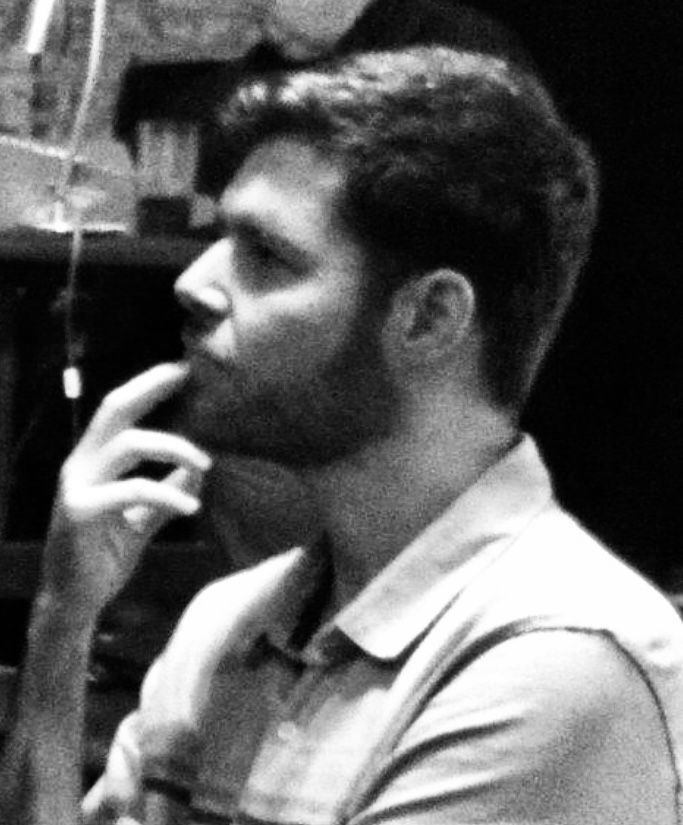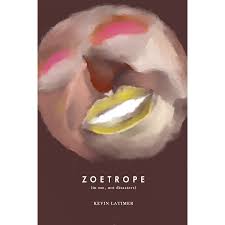ISSN: 1941-4137
POETRY THAT ENACTS THE ARTISTIC AND CREATIVE PURITY OF GLASS
POETRY THAT ENACTS THE ARTISTIC AND CREATIVE PURITY OF GLASS

R.M. Haines is a member of the Poets Union. His poetry has appeared in a variety of places, most recently Protean and Prolit. In addition, his first collection of poems, A Dark Address, was released in April 2020 as a free PDF on Gumroad.com. In 2021, his second collection, Interrogation Days, will be released by woe eroa.
May 24, 2021
Edited by Stephanie Kaylor
Edited by Stephanie Kaylor
The Dead Made Human: Review of Zoetrope by Kevin Latimer
 Zoetrope
by Kevin Latimer
Grieveland, 2020
A zoetrope is an early precursor to the motion picture. Still images depicted on a wheel were turned to mimic motion. Made obsolete by modern cinema, this dead technology is, etymologically, a wheel of life: its turning tries to represent life, to create life, out of stasis and limitation. Similarly, in Kevin Latimer’s first full length collection, Zoetrope (Grieveland, 2020) we encounter a voice conscious of its own artifice and expiration date — its inevitable obsolescence and stasis — even as it works to create life that exists beyond the mere turning of a wheel.
This consciousness of artifice is everywhere in the poems. It exists in the poems’ figuration — poems are presented as operas, events are described as tragedies after which an audience “floods out of the theater” — as well as in its use of form. Mixed in with lyric poems are concrete and visual poems, as well as dramatic dialogue (Latimer is also a playwright). We have blocks of text with repeated phrases, as well as actual drawings of doors and boxes with words inside. Additionally, the artifice of textuality itself is foregrounded, as we have words crossed out (“
Zoetrope
by Kevin Latimer
Grieveland, 2020
A zoetrope is an early precursor to the motion picture. Still images depicted on a wheel were turned to mimic motion. Made obsolete by modern cinema, this dead technology is, etymologically, a wheel of life: its turning tries to represent life, to create life, out of stasis and limitation. Similarly, in Kevin Latimer’s first full length collection, Zoetrope (Grieveland, 2020) we encounter a voice conscious of its own artifice and expiration date — its inevitable obsolescence and stasis — even as it works to create life that exists beyond the mere turning of a wheel.
This consciousness of artifice is everywhere in the poems. It exists in the poems’ figuration — poems are presented as operas, events are described as tragedies after which an audience “floods out of the theater” — as well as in its use of form. Mixed in with lyric poems are concrete and visual poems, as well as dramatic dialogue (Latimer is also a playwright). We have blocks of text with repeated phrases, as well as actual drawings of doors and boxes with words inside. Additionally, the artifice of textuality itself is foregrounded, as we have words crossed out (“i want to die until
i do. i want to touch
everything before
i’m dust.
The poems confess and bear witness throughout to the terrors and grief of illness, to the death of the poet’s own mother (to whom the final section, after the notes, is explicitly addressed), and to the violence and injustice inflicted upon Black life. And at times, Latimer warns us to read beyond the death signified in these pages: even the book’s subtitle tells us not to look only at “disasters.” For within these hauntings and fears, the poems dream of motion, of flight and escape.
We see this longing for flight, in all senses, most clearly in one fifteen-page section of the book grouped under the repeated title, “ORIGINALLY, a space opera.” In this section, the poems most forcefully engage their central crux of death vs. the humanizing power of love and imagination. In its title, we are told that these are only the remains of an original science-fiction opera, and in place of this original intent is something much more frightening. What begins with “[black] boys in space now” and ““[black] boy in space is all the rage” soon begins to wrestle with the murder of Tamir Rice by Cleveland police officers (Latimer lives in Cleveland, where Grieveland is also based). One passage reads:
I’ve seen the underside of Mars, that place
where Tamir sleeps and dreams wonderous things:
he drives an asteroid, a comet! in space,
it is common for black boys to do this
in space, he buys his mother Neptune, his father
Venus, space is the place for a black boy’s genius!
Echoing Sun Ra (“space is the place”) and the entire dream of Afrofuturism, this passage gives us justice and joy for Tamir Rice and for Black life itself only in the context of the unreal. And its ending is agonizing:
in space, that boy dreams
of no tragedies, no profits
no blood stains / suddenly,
his mother screams —
And here, in one of the poems concrete gestures, the words “those shots” ring out across multiple pages: one hundred and thirty-seven times — the number of shots fired by the officers who killed Tamir. In the ensuing passages, we read:
[/4 black
boys 2b
astronauts///!
the entire world must explode / must be
thrown off its axis / must !] rearrange itself
Ultimately, this is the revolutionary nucleus of the book: that justice and love for Black life is a fulcrum to transform the world, to bring imagination and creation — the escapes and explorations and ascensions — into something more than tragic flight.
Later, in the poem “at the end of the space opera,” we see the curtain come up as the Black boys ascend and triumph fills the air. We see patrons and those who profited from the tragedy. And we read:
in this theater,
ghosts fill up my vision.
. . .
a little black boy sings a hymn.
Tamir rips dandelions from the street.
some little boy throws a brick
through a cop car window/
millions march down
the street; chant real loud.
I do not think
about my mortality
tonight, for this night, i see
ghosts become human among me.
Here, while reminded of its own artifice — in the exit from the poem’s theater — imagination sees the dead become not living but human: as tho redeemed from death’s inhumanity — or as tho death itself were humanized. And this is the longing of the zoetrope: to turn the wheel until the dead begin to move with us again. Latimer’s work seems gripped with the knowledge that all futures depend on our doing justice to the dead: that they belong not to the past, but to a future that was terminated — a future that we, the living, have not yet realized. And the poems wrestle with this messianic dilemma, which is also thew dream of communism: that the future’s justice cannot come to be unless the world we are now in ceases. As an earlier poem in the collection tells us: “we watch old / funerals become new births.”
As the book draws to a close, the poems approach these cosmic questions with a humor that is alternately gentle and heartbreaking. The title poem’s opening lines announce, “this is Kevin to God, do you hear me? / there’s a little static.” The poet then offers a report to God in which “bombs (like real ones) are dropping.” After a section break, we read: “I hang my EKG on my wall so i know that i know i’m alive. / that’s the thing about alive: waiting at the end point, somewhere-disaster.” Here, we approach the sacred paradoxes of gnostics and mystics: life hides inside its ending, waiting for us from inside ourselves. In “Love Poem,” which is the final poem before the Notes, Latimer speaks as a kind of failed deity: “first, I built the sky & everything under it is chaos. // this is my fault. / I apologize.” As the poem unfolds:
here? just you, me, & this light.
. . .
in the light, we learn & re-learn new codes
for language
. . .
the light is a directionless series of hills.
i’ve got a smart parrot.
follow me, he’ll lead the way.
let’s get lost in it.
Here, the humane and intimate core of Latimer’s work shines through most fully, and the poem reaches out to its reader directly, inviting them to join him in the light. It is this gentleness and wisdom of these poems that works to keep life human, even as they show us how ghostly we already are.
Visit Grieveland's Website
Glass: A Journal of Poetry is published monthly by Glass Poetry Press.
All contents © the author.
All contents © the author.





